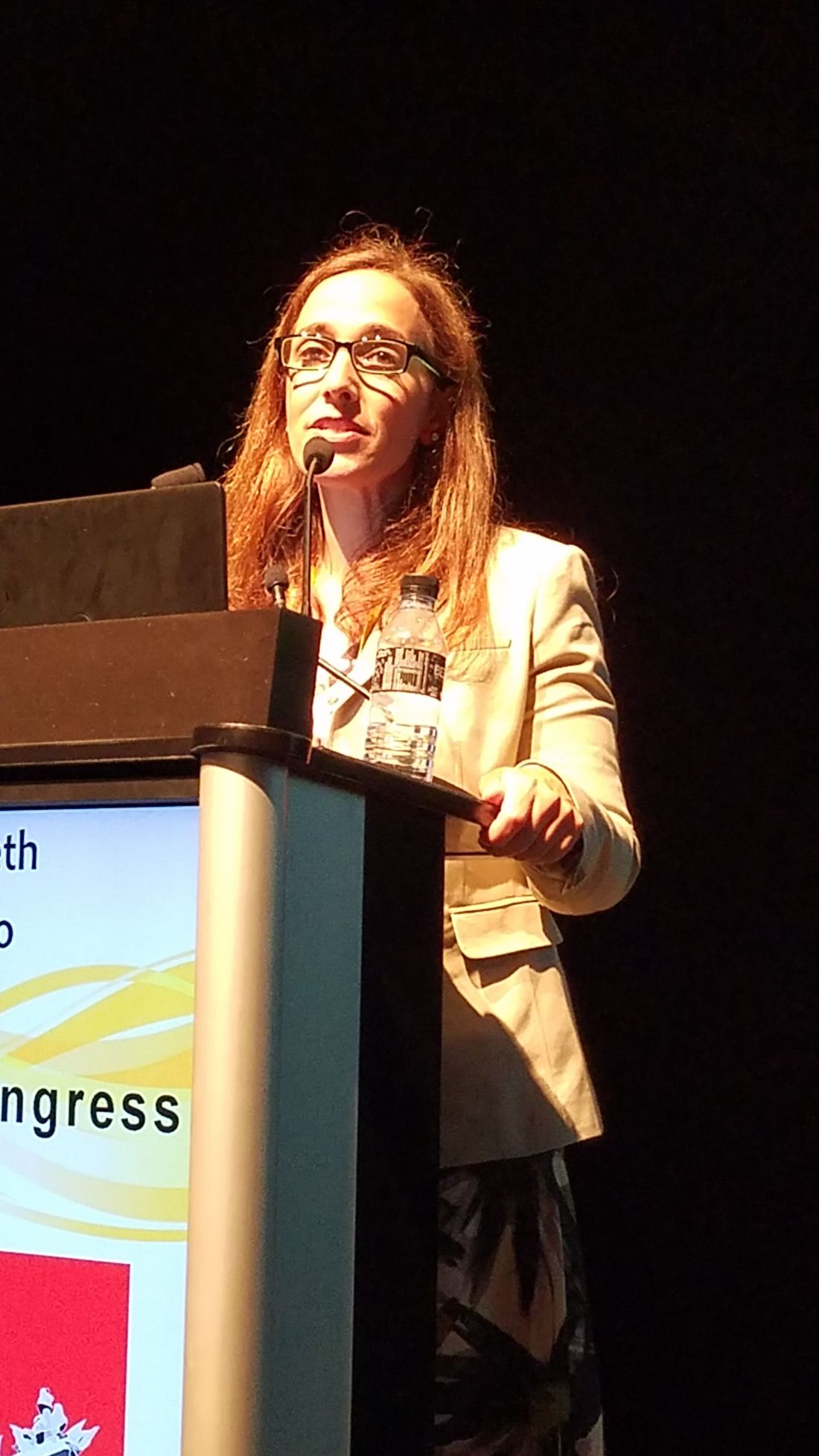User login
MADRID – The anti-IL-23 antibody ustekinumab cleared enthesitis significantly better than did TNF-blockade in a small, open-label trial of patients with psoriatic arthritis
After 6 months on the drug, 71% of those taking the antibody achieved a score of 0 on the Spondyloarthritis Research Consortium of Canada (SPARCC) scale, representing a complete absence of enthesitis, Elizabeth Araujo, MD, said at the European Congress of Rheumatology. Just 38% of those on TNF-inhibitors achieved that score.
Enthesitis is often more bothersome to arthritis patients than their primary disease, said Dr. Araujo of the Centre of Internal Medicine, Universitätsklinikum Erlangen, Germany.
“Despite being a hallmark of PsA patients, enthesitis still receives rather peripheral attention as an outcome, especially when compared with ‘classical’ arthritis. Nonetheless, in clinical practice, enthesitis is an important factor for PsA-associated pain in many patients,” explained Dr. Araujo.
Yet it’s frequently ignored or under-treated. When it is addressed, enthesitis is often treated using TNF-inhibitors. But recent increases in the treatment options for PsA patients got Dr. Araujo thinking that PsA patients with enthesitis might respond better to a different therapy.
She investigated this with the open-label ECLIPSA trial, which randomized 51 PsA patients (47 with active enthesitis) to a 6-month treatment regimen of ustekinumab or a TNF-inhibitor. The primary endpoint of the observational study was a SPARCC score of 0.
Patients were a mean of 61 years, with a mean disease duration of 2.5 years. The mean baseline SPARCC score was 4. The mean Psoriatic Area and Severity Score (PASI) was 3.
Patients’ arthritis symptoms responded equally well to both drugs, with similar marked decreases in tender and swollen joint counts. But there was a clear, significant between-group separation on the SPARCC score, with 71% of the ustekinumab group reaching a 0 compared to 38% of the TNF-inhibition group.
Ustekinumab also effected better skin clearance than TNF-inhibition, she said. Among the TNF-inhibition group, about 20% achieved a PASI 90 and 20%, a PASI 100. Among those taking ustekinumab, about 80% achieved a PASI 90 and 55% a PASI 100.
The data point the way to more stratified treatment approaches for PsA patients, where PsA that predominantly involves enthesitis is treated by drugs like ustekinumab, Dr. Araujo said. Since both TNF-inhibitors and ustekinumab are approved for treatment of PsA, treatment could be tailored.
“Stratification of PsA patients according to clinical features (enthesitis driven vs. arthritis driven) appears within reach and will allow a more selective use of cytokine-blocking agents in PsA in the future,” said Dr. Araujo.
“More attention on enthesial-driven PsA patients is needed in the future as this patient group is well known to clinicians working in the PsA field but is massively underrepresented in clinical studies. Comparative studies of biological [disease-modifying antirheumatic drugs] in PsA need to take into account the differences in the clinical profile of PsA patients and should not be confined to the traditional polyarticular arthritis–driven disease population,” she added.
Dr. Araujo had no financial disclosures.
msullivan@frontlinemedcom.com
On Twitter @Alz_gal
MADRID – The anti-IL-23 antibody ustekinumab cleared enthesitis significantly better than did TNF-blockade in a small, open-label trial of patients with psoriatic arthritis
After 6 months on the drug, 71% of those taking the antibody achieved a score of 0 on the Spondyloarthritis Research Consortium of Canada (SPARCC) scale, representing a complete absence of enthesitis, Elizabeth Araujo, MD, said at the European Congress of Rheumatology. Just 38% of those on TNF-inhibitors achieved that score.
Enthesitis is often more bothersome to arthritis patients than their primary disease, said Dr. Araujo of the Centre of Internal Medicine, Universitätsklinikum Erlangen, Germany.
“Despite being a hallmark of PsA patients, enthesitis still receives rather peripheral attention as an outcome, especially when compared with ‘classical’ arthritis. Nonetheless, in clinical practice, enthesitis is an important factor for PsA-associated pain in many patients,” explained Dr. Araujo.
Yet it’s frequently ignored or under-treated. When it is addressed, enthesitis is often treated using TNF-inhibitors. But recent increases in the treatment options for PsA patients got Dr. Araujo thinking that PsA patients with enthesitis might respond better to a different therapy.
She investigated this with the open-label ECLIPSA trial, which randomized 51 PsA patients (47 with active enthesitis) to a 6-month treatment regimen of ustekinumab or a TNF-inhibitor. The primary endpoint of the observational study was a SPARCC score of 0.
Patients were a mean of 61 years, with a mean disease duration of 2.5 years. The mean baseline SPARCC score was 4. The mean Psoriatic Area and Severity Score (PASI) was 3.
Patients’ arthritis symptoms responded equally well to both drugs, with similar marked decreases in tender and swollen joint counts. But there was a clear, significant between-group separation on the SPARCC score, with 71% of the ustekinumab group reaching a 0 compared to 38% of the TNF-inhibition group.
Ustekinumab also effected better skin clearance than TNF-inhibition, she said. Among the TNF-inhibition group, about 20% achieved a PASI 90 and 20%, a PASI 100. Among those taking ustekinumab, about 80% achieved a PASI 90 and 55% a PASI 100.
The data point the way to more stratified treatment approaches for PsA patients, where PsA that predominantly involves enthesitis is treated by drugs like ustekinumab, Dr. Araujo said. Since both TNF-inhibitors and ustekinumab are approved for treatment of PsA, treatment could be tailored.
“Stratification of PsA patients according to clinical features (enthesitis driven vs. arthritis driven) appears within reach and will allow a more selective use of cytokine-blocking agents in PsA in the future,” said Dr. Araujo.
“More attention on enthesial-driven PsA patients is needed in the future as this patient group is well known to clinicians working in the PsA field but is massively underrepresented in clinical studies. Comparative studies of biological [disease-modifying antirheumatic drugs] in PsA need to take into account the differences in the clinical profile of PsA patients and should not be confined to the traditional polyarticular arthritis–driven disease population,” she added.
Dr. Araujo had no financial disclosures.
msullivan@frontlinemedcom.com
On Twitter @Alz_gal
MADRID – The anti-IL-23 antibody ustekinumab cleared enthesitis significantly better than did TNF-blockade in a small, open-label trial of patients with psoriatic arthritis
After 6 months on the drug, 71% of those taking the antibody achieved a score of 0 on the Spondyloarthritis Research Consortium of Canada (SPARCC) scale, representing a complete absence of enthesitis, Elizabeth Araujo, MD, said at the European Congress of Rheumatology. Just 38% of those on TNF-inhibitors achieved that score.
Enthesitis is often more bothersome to arthritis patients than their primary disease, said Dr. Araujo of the Centre of Internal Medicine, Universitätsklinikum Erlangen, Germany.
“Despite being a hallmark of PsA patients, enthesitis still receives rather peripheral attention as an outcome, especially when compared with ‘classical’ arthritis. Nonetheless, in clinical practice, enthesitis is an important factor for PsA-associated pain in many patients,” explained Dr. Araujo.
Yet it’s frequently ignored or under-treated. When it is addressed, enthesitis is often treated using TNF-inhibitors. But recent increases in the treatment options for PsA patients got Dr. Araujo thinking that PsA patients with enthesitis might respond better to a different therapy.
She investigated this with the open-label ECLIPSA trial, which randomized 51 PsA patients (47 with active enthesitis) to a 6-month treatment regimen of ustekinumab or a TNF-inhibitor. The primary endpoint of the observational study was a SPARCC score of 0.
Patients were a mean of 61 years, with a mean disease duration of 2.5 years. The mean baseline SPARCC score was 4. The mean Psoriatic Area and Severity Score (PASI) was 3.
Patients’ arthritis symptoms responded equally well to both drugs, with similar marked decreases in tender and swollen joint counts. But there was a clear, significant between-group separation on the SPARCC score, with 71% of the ustekinumab group reaching a 0 compared to 38% of the TNF-inhibition group.
Ustekinumab also effected better skin clearance than TNF-inhibition, she said. Among the TNF-inhibition group, about 20% achieved a PASI 90 and 20%, a PASI 100. Among those taking ustekinumab, about 80% achieved a PASI 90 and 55% a PASI 100.
The data point the way to more stratified treatment approaches for PsA patients, where PsA that predominantly involves enthesitis is treated by drugs like ustekinumab, Dr. Araujo said. Since both TNF-inhibitors and ustekinumab are approved for treatment of PsA, treatment could be tailored.
“Stratification of PsA patients according to clinical features (enthesitis driven vs. arthritis driven) appears within reach and will allow a more selective use of cytokine-blocking agents in PsA in the future,” said Dr. Araujo.
“More attention on enthesial-driven PsA patients is needed in the future as this patient group is well known to clinicians working in the PsA field but is massively underrepresented in clinical studies. Comparative studies of biological [disease-modifying antirheumatic drugs] in PsA need to take into account the differences in the clinical profile of PsA patients and should not be confined to the traditional polyarticular arthritis–driven disease population,” she added.
Dr. Araujo had no financial disclosures.
msullivan@frontlinemedcom.com
On Twitter @Alz_gal
AT EULAR 2017
Key clinical point:
Major finding: After 6 months, 71% of those taking ustekinumab and 38% of those taking TNF-blockers achieved total enthesitis clearance.
Data source: The open-label trial randomized 51 patients - 47 of whom had active enthesitis.
Disclosures: Dr. Araujo had no financial disclosures.

